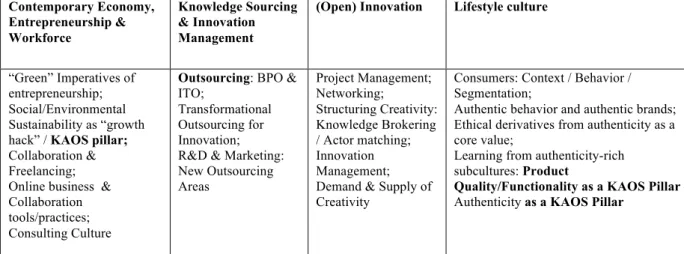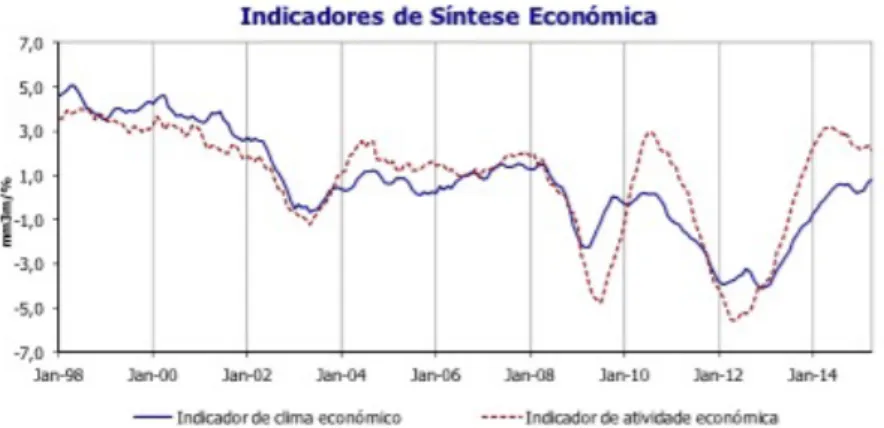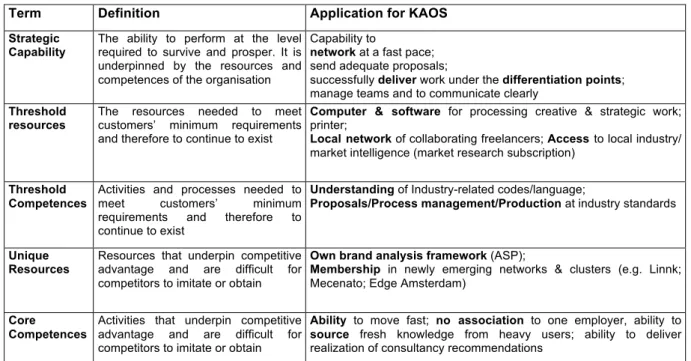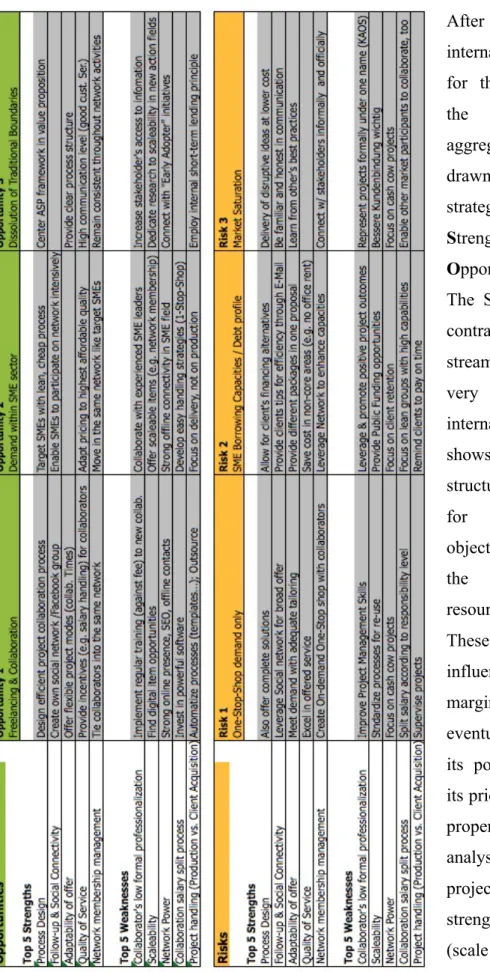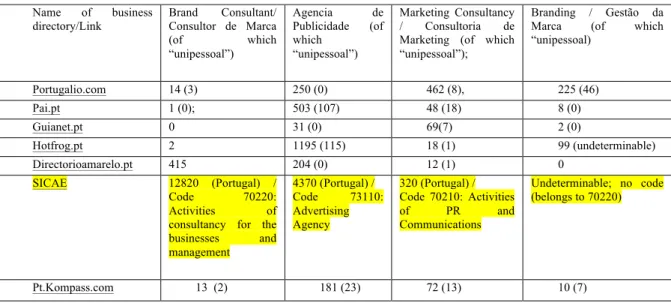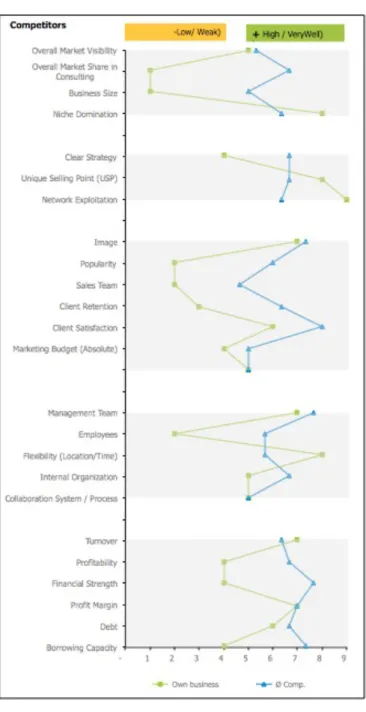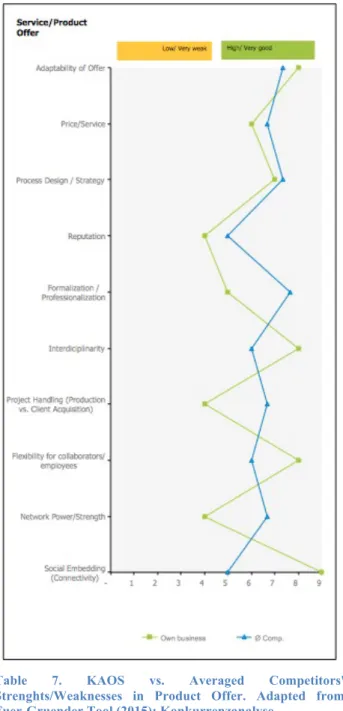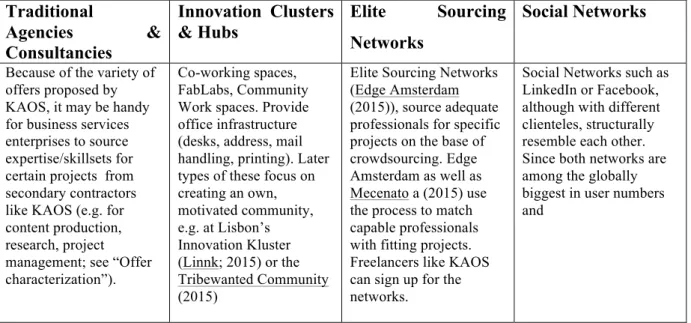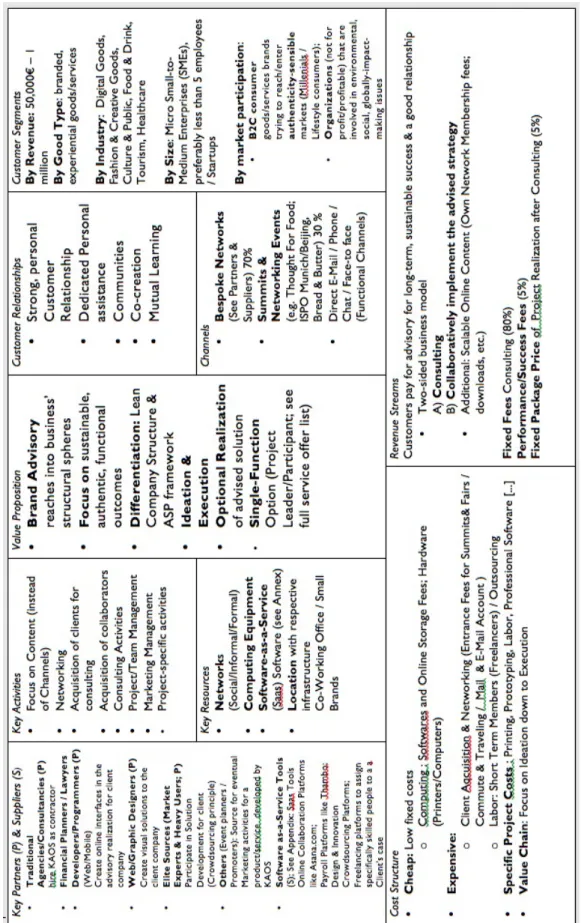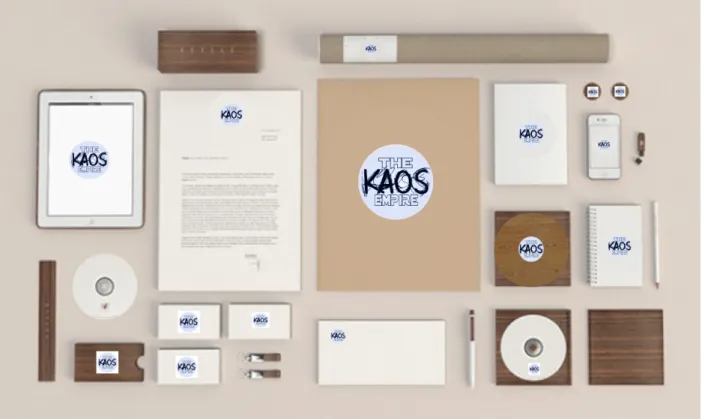KREATIVE
ACTS
OF
STRATEGY
(KAOS)
A BUSINESS PLAN FOR A NEW TYPE OF SMALL CONSULTANCYNina Silvia Wiegers
Project submitted as partial requirement for the conferral of Master in Marketing
Supervisor:
Prof. Ana Margarida Mendes Camelo Oliveira Brochado, ISCTE Business School, Departamento de Marketing, Operações e Gestão Geral
KR
E
AT
IVE
AC
T
S
OF
STR
A
TEG
Y
(K
A
O
S
)
A BU S IN E S S P L A N F O R A N E W T Y P E O F S M A L L CO N S U L T A N CY N ina W ie ge rsDECLARAÇÃO
Nome
Endereço eletrónico: Telefone: /
Número do Bilhete de Identidade: Nacionalidade: __________________________________
Doutoramento
❒
Mestrado❒
Título dissertação? / Tese?
Orientador (es):
Ano de conclusão: Designação do 'mestrado' ou do 'ramo de conhecimento do doutoramento':
Declaro sob compromisso de honra que a tese/dissertação agora entregue corresponde à versão final. Caso contrário, será posteriormente apresentada a que venha a ser aprovada pelo júri.
Declaro que concedo ao ISCTE - IUL e aos seus agentes uma licença não-exclusiva para arquivar e tornar acessível, através do seu repositório institucional, nas condições abaixo indicadas, a minha tese ou dissertação, no todo ou em parte, em suporte digital.
Concordo que a minha tese ou dissertação seja colocada no repositório do ISCTE -I UL com o seguinte estatuto (assinale um): 1. ❒ Disponibilização imediata do conjunto do trabalho para acesso mundial;
2. ❒ Disponibilização do conjunto do trabalho para acesso exclusivo no ISCTE – IUL durante o período de ❒ 1 ano, ❒ 2 anos ou ❒ 3 anos, sendo que após o tempo assinalado autorizo o acesso mundial. 3. ❒ Disponibilização do conjunto do trabalho para acesso exclusivo ao ISCTE - IUL.
Retenho todos os direitos de autor relativos à tese ou dissertação, e o direito de a usar em trabalhos futuros (como artigos ou livros).
Lisboa, Assinatura:
My gratitude holds for
Alfred, Barbara, Heidi & Hartmut (alphabetic!), as they have supported me as long as I exist; For Silvia, as my admiration for her remains unspoken too often;
For Tiago, as his presence is the greatest gift to me; for my whole family;
And for my friends that are potentially the greatest firends imaginable.
My gratitude additionally holds for my supervisor, Ana Brochado, and my teachers at ISCTE Business School, Lisbon, as my academic path wouldn’t have led to where it directs now if it
Abstract
The proposed business is designed as a small Creative Brand Consulting and Collaborative Innovation firm that caters to Small-to-Medium sized (SME) consumer goods/services producing enterprises. It derives its innovative approach from a proprietary framework, which is implemented as an analysis tool to audit a client’s business in a strategically new way. The ASP framework draws its pillars, Authenticity, Sustainability, and Product Functionality from the condensation of contemporary discourse about these topics. All of the pillar traits can be found in many of today’s successful, global brands, which encourages to manifest them as a strategically applicable tool. The overall goal is hereby to reduce so-called negative externalities, that is, to reduce environmental/societal harm and to enhance outcomes’ functional value to eventually create a more friendly but efficient co-living environment. It is believed that doing so increases a brands’ intrinsic value through claiming a socially beneficial purpose apart from the purpose to grow infinitely. Apart from offering Management Consulting services for small businesses within the respective context, the proposed plan stipulates a risk diversification through the offer of additional business services. The innovative approach focuses on a lean business structure, which entails to form a “temporary” enterprise by collaborating with contractors only when needed, that is, project based. The proposed business aims to grow slowly and organically, as it is demanded by its values and its mission to successfully shape a consumption environment that both grows and produces positive societal outcomes.
M310: Marketing
Keywords: Branding; Entrepreneurship
Z100: Cultural Economics; Economic Sociology; Economic Anthropology
Keywords: Economic Sociology; Cultural Traits
Portuguese
O negócio proposto é designado como uma pequena consultoria criativa de marca e firma de inovação colaborativa que presta serviços a pequenas e médias empresas (PME) produtoras de bens consumíveis (englobando também, nesta categoria, bens perecíveis) e/ou serviços. As estratégias inovadoras, na qual os serviços propostos neste negócio são baseados, derivam de um framework da empresa que é implementado como uma ferramenta de análise, de modo a auditar o negócio do cliente duma nova forma estratégica, na qual foi dada a definição de ASP framework. O ASP framework cria os seus pilares, Autenticidade, Sustentabilidade, e funcionalidade do Produto, como um resultado da condensação de discursos contemporâneos referentes aos mesmos. Todas as características dos pilares podem ser encontrados em inúmeras marcas globais de sucesso, pelo que encoraja a manifestá-las como uma estratégia aplicável.Tendo por base de aplicação o meio retratado precedentemente, o objetivo é reduzir as negatividades externas, ou seja, reduzir perigos ambientais e sociais de modo a aprimorar o valor funcional (resultados) com o intuito de criar um ambiente eficiente de coabitação societal e, eventualmente, mais amigável. A sua aplicação é espectável na medida que contribui para um incremento no valor intrínseco da marca, reivindicando uma proposta de benefício social e contrariando a proposta comum de crescimento infinito. Para além de oferecer consultoria de gestão de serviços para pequenas empresas (PE), englobadas no respetivo contexto, o plano proposto estipula uma diversificação de riscos através duma oferta adicional de serviços de negócios. Esta aproximação inovadora foca-se numa estrutura de aprendizagem do negócio, que consiste na formação de uma empresa temporária, colaborando com contratantes apenas quando preciso consoante o projeto. Em suma, o negócio proposto procura um crescimento vagaroso e orgânico, tal como é exigido através dos seus valores e missão para moldar, com sucesso, um ambiente de consumismo que não só cresce mas
Index
Executive Summary ... 1
Identification of the Promoter and the Innovative Proposal ... 5
Part I: Literature Review ... 6
1 Contemporary Economy ... 6
1.1 Growth through Environmental / Social Sustainability ... 6
1.2 Knowledge Sourcing ... 10
1.2.1 Outsourcing ... 11
1.2.2 Open Innovation ... 12
2 Beyond Consulting: Transition to collaboration and flexible contracting ... 14
2.1 (Management) Consulting in Europe: No standards? ... 16
3 Authenticity: A central concept shaping consumption culture ... 18
3.1 What is authenticity? Definitions ... 18
3.2 The Authentic Brand ... 21
3.3 Learning from Authentic Lifestyles: Functional consumption ... 22
3.3.1 Product/Service Performance as consumption trend ... 23
3.3.2 Takes from Authenticity and Product Functionality ... 24
4 Methodology ... 25
4.1 Secondary Data Collection: Observation, interpretative Data and Projective methods . 26 4.1.1 Literature review, the ASP framework and related contexts: Deductive field data analysis 26 4.1.2 Market & Industry Research: Indirect, unstructured Observation of online archives ... 27
4.2 Primary Data Collection ... 28
4.2.1 Market Study I: Query Hit Comparison ... 28
4.2.2 Market study II: Qualitative Interviews A ... 30
4.2.3 ASP Framework Viability: Qualitative Interviews B ... 31
5 Reference Framework ... 32
5.1 A New Branding Framework With a Collaborative Back Bone: The ASP framework .. 32
5.2 Authenticity (A) as a framework pillar ... 32
5.3 Product Functionality (P) as a framework pillar ... 33
5.4 Environmental and Social Sustainability (S) as a framework pillar ... 34
5.5 The Framework explained ... 34
Part II: Business Plan ... 36
6 Introduction ... 36
7 Market Analysis ... 37
7.1 Organization Environment I: PEST Analysis (external analysis) ... 37
7.1.2 Political Environment ... 37
7.1.3 Fiscal Environment ... 38
7.1.4 Economical Environment ... 39
7.1.5 Social Environment ... 41
7.2 Organization Environment II: The European (and Portuguese) Management Consulting industry – Porter’s five forces ... 41
7.3 Internal Analysis: VRIN Analysis & Strategic Capabilities ... 43
7.4 Competitive Analysis: Integrated SWOT ... 44
7.4.2 Key Success factors ... 45
8 Market Study ... 46
8.1 Market Study I: Findings of Qualitative Interviews B/Consulting Environment ... 46
8.1.3 External Knowledge Acquisition and Open Innovation ... 47
8.1.4 Innovation and Success Management ... 48
8.2 Market Study II: Query Hit Analysis ... 49
8.3 Benchmarks ... 50
9 Competitive Analysis ... 52
9.1 Potential Partners/Networks ... 55
10 Objectives Of The Plan ... 55
11 Strategy Development ... 56
11.1 Mission, Vision, Values ... 56
11.2 The Business Model Canvas ... 57
12 Global Strategy: The Brand Elements & Services ... 58
12.1 Visual Elements ... 58
13 Implementation Policies ... 59
13.1 Segmentation ... 59
13.1.2 Different Industries in Portugal ... 59
13.1.3 Needs in Authenticity, Sustainability & Product Functionality of small businesses in different Industries ... 60
13.2 Targeting ... 61
13.3 Positioning ... 61
13.4 Place ... 62
13.5 Pricing ... 62
13.6 Promotion & Communication ... 63
13.6.2 Overall Strategy, Tone, Theme ... 63
13.6.3 Communicational Activities ... 63 13.6.4 Timeline ... 64 13.6.5 Budget ... 64 13.6.6 Measurements ... 64 14 Financing ... 65 15 Financial Evaluation ... 65 15.1 Assumptions ... 65 15.2 Cost budgeting ... 66
15.3 Profit Margin & Cost structure by Turnover ... 67
15.4 Account Balance vs. Credit & Debit Flows ... 67
15.5 Breakeven ... 68
15.6 Profit/Loss account ... 68
15.6.2 Three Year’s Profit/Loss Account ... 69
16 Implementation Requirements ... 69
16.1 Legal and Tax Requirements for a flexible freelance Consulting business in the European Union ... 69
16.2 Business Requirements and Applicable Taxation ... 70
17 Planning Objectives: PERT Chart ... 71
18 Bibliography ... 73
18.1 Websites and Electronic Sources ... 80
19 Appendices ... 86
19.1 Transformational Outsourcing ... 86
19.2 Business-Tools & Saas-Services ... 87
19.3 Qualitative Interviews A& B, Questionnaires, Full Interviews & Findings ... 91
19.4 VRIN Analysis ... 110
19.6 Offer Characterization ... 115
19.7 Complete Brand Audit ... 117
19.8 QHA (Query Hit Analysis) Competitor List ... 130
19.9 In-depth Competitor Analysis ... 131
19.10 Pricing ... 134
Table Index Table 1. Knowledge Domains in the KAOS project. ... 5
Table 2. Unique Resources and Capabilities for KAOS. ... 43
Table 4. Key Competing Factors. ... 45
Table 5. Query Hit Analysis for different Marketing professions in the area of Lisbon, Portugal. ... 49
Table 8. Different type of networks. ... 55
Table 9. Different Industries in Portugal. ... 60
Table 10. Needs of Authenticity, Product Functionality and Sustainability of SMEs in Portugal. ... 60
Table 11. Profit Margin & Cost by turnover. ... 67
Table 12. Proft/Loss Account (ROI). ... 68
Table 13. October 2015-2016 projected cash flow. ... 69
Table 14. October 2016-2017 projected cash flow. ... 69
Table 15. October 2017-2018 projected cash flow. ... 69
Table 16. VRIN Analysis. ... 111
Table 17. KAOS vs. 3 Strongest Competitors. ... 131
Table 18.KAOS vs. Competitors' Product/Service. ... 132
Table 19. KAOS vs. Competitors' Strengths & Weaknesses.. ... 133
Table 20. Price Calculation on basis of yearly billable hours. Figure Index Figure 1. The Hierarchy of Consumer Sensibilities...19
Figure 2. The ASP framework...32
Figure 3. Indicators of economic synthesis. ... 39
Figure 4. The Business Model Canvas...39
Figure 5. Logo on visual artifacts of the brand...58
Figure 6. Perceptual Map. ... 61
Figure 7. Account Balance vs. Credit& Debit Flows ... 67
Figure 8. Breakeven Graphic...67
Figure 9. Mapping the decision for different types of Outsourcing. ... 87
Figure 10. Analysis of Strenghts and Weaknesses (SWOT) ... 112
Figure 11. Trend Analysis and Opportunity / Risk characterization. ... 113
Executive Summary
The business plan designs KAOS (Kreative Acts of Strategy), a small Creative Brand Consulting and Collaborative Innovation firm that caters to Small-to-Medium (SME) consumer goods/services producing enterprises.
It draws its concept from the review of contemporary knowledge discourses and economical status quos. In the limelight of economical downturn and over-saturation of consumer goods markets, the paper proposes a new analytic lens for marketing consulting and auditing. Through the review of these domains, the paper introduces the ASP (Authenticity, Sustainability, Product/Service Functionality) framework. It is held that successful brands within the consumer goods/services market feature a unique, differing mix of traits that are summarized in the framework’s ASP values. For that reason, these pillars are adopted to structure any client business in a similar, successful way. The framework represents a condensation of contemporary economic discourse into a norm-based approach to identify and utilize opportunities in these areas, to eventually implement them into a client’s operational activities and organizational structure. The attempt to conceptualize the mentioned areas constitutes a preliminary draft; however, it shows a possible direction of capturing recent economic, societal and environmental developments within a practically applicable model. The model aims to change organizational structures beyond amendments in communicational efforts towards an integrated, holistic interlacement of the framework with a client brand’s foundations. The guideline values hereby revolve around the idea that goods and services need to have character traits that reach beyond the reflection of status and possession. Instead, A, S and P help to enhance an offered product’s / service’s value through conceptualizing them as a authentically, environmentally, and functionally beneficial offer to society. The overall goal is to reduce so-called negative externalities, that is, to reduce environmental/societal harm and to enhance outcomes’ functional value to eventually create a more friendly but efficient co-living environment. It is believed that doing so increases a brands’ intrinsic value through claiming a socially beneficial purpose apart from the purpose to grow infinitely. The own business operations are shaped and influenced by the design of this framework. KAOS provides brand audit sessions to clients using both the ASP framework and traditional audit methods to identify opportunities for re-shaping the client’s strategic direction. The business offers additional services that focus on the realization of the consulted strategies, such as Project management for creative projects, Video Direction, and Online/Offline Marketing Management. The client can also purchase these services separately at a fixed hourly rate. KAOS’ strategic direction heads towards working within spheres of
cultural and experiential consumer experience goods & services. That is, it consult companies that aim to sell their goods & services to a consumer base that is savvy of Lifestyle choices, well connected, and sensitive to the issues that are digested in the ASP framework. With this approach, KAOS focuses on hitting the Zeitgeist and on co-shaping the way how goods/services are consumed. It bases on a new, lean company model that may hire contractors for specific projects rather than expanding with a fixed set of employees. The values derived from the ASP framework also shape the business’ strategic behavior. The greatest goal is always to deliver services & products that are environmentally & socially favorable, functional, meaningful, and related to a credible heritage. The business aims to grow organically so that the aim of economical/social harm reduction can be met. KAOS largely embeds itself in offline and online networks to leverage and identify business opportunities in niche areas and less formalized industries. It harnesses this network power additionally through employing online inbound Marketing strategies, such as the maintenance of Social Media profiles, Blog content production, and SEO management. The presented business plan is tailored to the idea of realizing projects independently of the location; however, the business plan analysis relates to the location of initiation, Lisbon, Portugal.
Sumário Executivo (Português)
Os projetos do plano de negócios KAOS (Kreative Acts of Strategy), uma pequena consultoria criativa de marca e firma de inovação colaborativa que presta serviços a pequenas e médias empresas (PME) produtoras de bens consumíveis (englobando também, nesta categoria, bens perecíveis) e/ou serviços. O seu conceito é desenvolvido após uma análise de conhecimento contemporâneo e status quos económicos. No centro de atenção de diminuições económicas e sobressaturação do mercado de bens consumíveis, o projeto propõe uma nova lente analítica, um novo algoritmo, para consultoria de marketing e auditoria. Através de uma revisão desses domínios, é introduzido o framework ASP (Autenticidade, Sustentabilidade, funcionalidade do Produto/Serviço). É suposto que marcas de sucesso dentro do sector de bens consumíveis e serviços apresentem uma mistura única e diferente das características possíveis de visualizar no framework proposto. Deste modo, esses pilares são adotados para estruturar qualquer negócios de clientes duma forma idêntica, uma forma de sucesso. O framework representa a condensação de discursos económicos contemporâneos numa aproximação baseada em normas de modo a identificar e utilizar as oportunidades nessas áreas, com o intuito de, eventualmente, implementá-las numa atividade operacional de clientes e organizar a estrutura. Tal demonstra uma tentativa para conceptualizar as áreas
mencionadas duma forma preliminar: contudo, demonstra uma direção possível de captura de desenvolvimentos recente a nível económico, societal e ambiental dentro de um modelo praticamente aplicável. O modelo aponta para uma mudança na estrutura organizacional para além das substituições em esforços comunicacionais na tentativa de uma integração, entrelaçamento holístico, entre o framework e as fundações de uma marca direcionada para clientes. Os valores das diretrizes são, por isso, examinadas em redor da ideia de que bens e serviços necessitam de ter traços característicos que alcançam além da reflexão de estatuto e possessão. Em vez disso, A, S e P ajudam na melhoria do valor de produto(s)/serviço(s) oferecidos após conceptualizá-los como autênticos, amigáveis ambientais e funcionalmente benéficos para a sociedade. O objetivo geral é reduzir as chamadas negatividade externas, ou seja, reduzir perigos ambientais/sociais e aprimorar os valores funcionais (resultados) com o intuito de criar um ambiente eficiente de coabitação societal e, eventualmente, mais amigável. A sua aplicação é espectável na medida que contribui para um incremento no valor intrínseco da marca, reivindicando uma proposta de benefício social e contrariando a proposta comum de crescimento infinito. As operações deste projeto de negócio são moduladas e influenciadas pelo design deste framework. KAOS providencia sessões de auditoria de marca para clientes usando tanto o ASP framework e métodos tradicionais de auditoria de modo a identificar oportunidades para reformular a direção estratégica do cliente.
A empresa oferece serviços adicionais focados na realização das estratégias consultadas, tais como gerenciamento de projetos para projetos criativos, direção de vídeo e online/offline gestão de marketing. O cliente pode, caso seja mais adequado no seu caso, adquirir serviços separadamente com uma taxa horária fixa. A direção estratégica do KAOS aponta para trabalhar dentro de esferas culturais e experienciais do consumidor dos bens e serviços. Ou seja, consulta empresas que procuram vender os seus bens e serviços a uma base de consumidores associados a algum lifestyle, bem conectados e sensíveis a problemas digeridos no framework ASP. Com esta abordagem, KAOS concentra-se em bater o Zeitgeist e em co-moldar a maneira como os bens/serviços são consumidos. Baseia-se, assim, num novo modelo de empresa, que pode recorrer a contratantes para projetos específicos, opondo-se à comum expansão com um conjunto fixo de funcionários. Os valores derivados do framework ASP, adicionalmente, contribuem para moldar o comportamento estratégico do negócio. O maior objetivo é sempre fornecer serviços e produtos que sejam ambientalmente e socialmente favorável, funcionais, significativos e associados a uma herança credível.
A empresa pretende crescer organicamente de modo a que os objetivos de reduzir danos económicos/sociais possam ser satisfeitos. Em grande parte KAOS incorpora-se em redes online e offline para identificar e alavancar oportunidades de negócios nas áreas de nicho e indústrias menos formalizadas. Ele aproveita este poder da Network, adicionalmente, empregando estratégias de marketing on-line de entrada, tais como a manutenção de perfis de social media, produção de conteúdo de blogs e gerenciamento de SEO. O plano de actividades apresentado é adaptado para a idéia de realizar projetos independentemente da localização. Todavia, a análise de plano de negócios refere-se ao local de origem, Lisboa, Portugal.
Identification of the Promoter and the Innovative Proposal
The promoter is the sole initiator and ideator of the business plan and its underlying framework, Nina Wiegers. The innovative edge derives from three distinct areas. Firstly, the promote developed a proprietary analysis lens that can be used within the proposed core operations, Management Consulting. The framework roots in the knowledge domains presented below:
The architecture of the KAOS project includes both its theoretical foundation as well as its business analysis within the respective domains. Secondly, the proposed consulting activities resemble traditional consulting strategies but are adaptable through the promoter’s capacities to deliver additional services that help the client to actually implement the advised strategy. Thirdly, the company structure resembles a freelance business with the option to hire contractors when needed, e.g. for the realization of said advisory. Here, the company’s lean structure and ability to utilize (in-)formal networks almost location-independently remders new opportunities and opens the stage for a globally interconnected type of business.
Contemporary Economy, Entrepreneurship & Workforce Knowledge Sourcing & Innovation Management
(Open) Innovation Lifestyle culture
“Green” Imperatives of entrepreneurship; Social/Environmental Sustainability as “growth hack” / KAOS pillar; Collaboration & Freelancing; Online business & Collaboration tools/practices; Consulting Culture
Outsourcing: BPO & ITO;
Transformational Outsourcing for Innovation; R&D & Marketing: New Outsourcing Areas Project Management; Networking; Structuring Creativity: Knowledge Brokering / Actor matching; Innovation Management; Demand & Supply of Creativity
Consumers: Context / Behavior / Segmentation;
Authentic behavior and authentic brands; Ethical derivatives from authenticity as a core value;
Learning from authenticity-rich subcultures: Product
Quality/Functionality as a KAOS Pillar Authenticity as a KAOS Pillar
Part I: Literature Review
1 Contemporary Economy
1.1 Growth through Environmental / Social Sustainability
“Reworking sustainability into the foundation of historic business has proven to be a tight-rope-walk of a task — the challenge to balance new innovations and consumer demands against an already established and ‘successful’ business model consisting of thousands of employees and billions of dollars of infrastructure.” (Donnatelli, 2014: 4)
The quote hints at a new era in scholar economic thinking. In this context, one of the greatest attempts in finding a solution to macro-economic phenomena such as the 2008 global financial crisis, the 2015 Greek debt crisis, or even the entire depletion of natural resources is to change a groundwork rule of the current economical system. Here, scholars, capitalism critics and supporters alike aim to (re-) design the idea of “benefit”, which represents our economical system’s intrinsic function. “Benefitting” in this case means to maximize one’s utility within a transaction, it means to grow.
The currency for a maximum of utility is of financial nature because of its universality– accumulated financial capital equals a “high life standard” or “freedom” (Sen, 1992). Simply put: Someone is happiest when he owns a lot of money. Nijaki (2013) points out that (aggregate) capital growth is the classical way to ensure “a better quality of life” (p. 253) in any economically operating community (e.g. cities) trough the concept of growth’s ability to incentivize investments, job creation, and even elimination of inequity between citizens. However, within a globalized marketplace that shifted economical powers from West to (South-) East (Chin, 2015) and within an environmentally harmful dependency on natural resources, more recent schools of economical thought suggest that growth will (and must) take on a different form or be completely eliminated as a measurement to reach prosperity (Woodrow 2013; Fullerton, 2015; Yunus: 2010; Nijaki, ibid.: 254).
However, a utilitarian economic system faces several flaws:
1) Because of its universality, financial growth is equaled to the maximization of an economic actor’s marginal utility (Nijaki, 2013). This assumption neglects that not every entity gains greatest “happiness” out of gaining more money since other factors (such as social embeddedness, good networks) may weigh in unmeasured (Sen, 1992). 2) The existence of natural and man-made inequalities, e.g. the distribution of natural resources in one country compared to another, biases the equality of opportunities for the greatest maximization of utility (Nijaki, 2013; Collier, 2010).
3) The assumption of the universal amount of utility received for the same amount of time/resources invested by different market participants is false– In fact, 4000$ earned do not bring the same utility everywhere on the world. Moreover, utility consists of more factors than GDP calculations (Schor, 2010; Sen, 1992; Yunus, 2010).
4) Economies’ high dependency on natural resources. Natural resources (e.g. wood) represent the raw material of every processed/produced good. They are “gratis” commodities. For the sake of capital growth (through minimized cost), compensation (for example through new planting projects in return for forest erosion) is limited to near zero, exhausting the natural source. In consequence, capital growth will be eliminated through systemic collapse. The only way to preserve capital growth at the current speed would be to compensate for the commodities taken. Therefore, preserving natural resources and environmental harm reduction is a fully economical need, which is recently only met through higher taxes (Woodrow, 2013; Collier, 2010; Blakley & Ley, 2010).
The current operating mode produces negative externalities of consumption and production such as “effluents, waste, and other forms of ecological disorganization” (Pellow, 2002: 34, after Nijaki, 2013:274), with Schnaiberg’s (2000) treadmill of production a characteristic growth problem. Unarguably, the here presented economists’ thought on growth examines a new, irreversibly changed, highly complex global market/environment ecosystem.
The macro-theoretic assumptions on economists’ most favorable determinant of wealth shows proof that our globalized environment leads capital growth to be an outdated measurement to reflect a sustainable maximization of utility, or equity. At the same time, utilitarianism’s relevance decreases through essential flaws in theory design. On the contrary, using growth for maximizing “happiness” is still what scholars consider necessary for sustainable, functional equity creation– Only, what is maximizing utility, if not infinite growth of capital?
It has been outlined that a fundamental reason for vast environmental and social dysbalances seems to be the current strive for unlimited financial growth, which simultaneously represents a measurement of wealth. Scholars agree, however, that maximization of utility for each individual for a great sum happiness remains favorable.
For instance, Blakley & Ley (2010) design a scenario in which growth remains important but changes its mode: Through investment in innovation and corporate networking, the maximization of utility happens through leaving the market’s participants with the flexibility to adjust to rapid changes of demand. Fullerton (2015) conceptualizes the “Regenerative
Economy” as a whole, leaning on his theoretical base of scholars like Jacobs’ (2000) thesis that economic systems behave well like (natural) ones. In consequence, Fullerton (ibid.) suggests to re-think growth as a means to collaboratively build a “flow network” (p.33) that eliminates “perpetual, unlimited growth” (p.3) for the sake of systemic health. Porter (2011) designs a shared value scenario eliminating trade-offs of Nijaki (2013) follows in consensus with Altschuler& Luberhoff (2003) on a hands-on, value-free notion of growth as a means to generate capital to achieve freedom as “everyone in the community can pursue his or her own values better [with money]” (Nijaki, ibid., p.257). That in conclusion means that at this historical point, it may be possible to redefine the way economies strive for a more ethically and environmentally sustainable profit growth design.
Our economical system powers the experience economy (Gilmore & Pine, 1999), in which any newly emerging product type is commoditized (Sassatelli, 2007: 10; Ritzer, 1983) and in which the utility derived from purchased “experiences” is authenticity and meaning (Mermiri, 2011). The relation of growth to product and service creation derives from the created items’ existential reason, namely the maximization of financial profit 1. The success of an item of
(in-)tangible nature is decided by the consumer. Price, location and quality are hard-fact determinants of a consumers’ decision towards an item, with the price determining the tradeoff between perceived quality and sacrifice (Monroe &Krishnan, 1985). Other influential traits such as consumer segment type or product/service complexity are subordinate (Mermiri, 2011). Therefore, consumers may not care about existential reason of an item/service as long as it serves its purpose, especially when consuming items that may not intrinsically harm anyone else (such as digital services, simple goods, etc). Moreover, the discussed ethical-normative claims to change capitalism mostly disregard industrial realities– As much as breaking the cycle of producing and designing for growth is desirable, the alternative approaches may well corrupt entire production cycles.
When addressing these issues, the concept of corporate sustainability reaches beyond business continuity– it represents a dynamic concept within a highly volatile environment that prioritizes the fulfillment of stakeholder expectations (Asif, 2011) with the ‘triple bottom line’ as systematic approach to include environmental/social efforts for risk minimization (ibid: 3). Pogutz et al. (2011) name sustainable ways as to produce and deliver goods/services
1
Fullerton (2015: 18): „When it comes to sustainability, our leading business schools are primarily engaged in [...] the mantra “Businesses can become more profitable through more intelligent operating practices that reduce
honorable but hard to implement– Arguing in the same way like Donnatelli (2010) in this section’s entry quote. The authors as well as Yunus (2010) hold that only large corporations may be able to implement “green” strategies through their wider scope and ability to finance potential growth risks through dedicating their major business focus on standard production. Even though efficient, clean environmental/social management may technically be realizable, “[M]arket growth rates may offset the environmental efficiency gains the firm is obtaining: when sales grow rapidly, improvements in environmental efficiency need to occur at a rate faster than market growth” to avoid competitiveness lags (Pogutz et al., 2011: 13). This applies intensively for emerging markets in developing countries. Other limitations are
• The lack of governmental trustworthiness to implement (and sanction) socially/environmentally sustainable standards (e.g. Germany’s abandonment of nuclear power with simultaneous purchase from neighboring countries),
• No threshold measurement of what and who is sustainable (Nijaki, 2013) • No relevance to producing entities (mindset; “consumers don’t care”) • No infrastructural oversight on “sustainable” ways to act.
Even though it seems that the current environment may not fundamentally turn away from growth, approaches to eliminate the mentioned negative externalities do exist (examples):
1) Re-conceptualization of business practices such as decoupling material throughput from growth measurement (e.g. Fullerton, 2015) or the implementation of a business cycle in which each cycle stage creates value instead of contra-balancing profit-corrupting constraints (Porter & Kramer, 2011).
2) Hybrid examples of growth maintenance and ethical/socially favorable behavior. On the purely goods-producing side, brand examples such as the Body Shop, Natura or Patagonia adopted “closed-loop factories, re-designed products, adopted innovative eco-friendly materials, and radically changed their business model in order to protect ecosystems and biodiversity“ (Pogutz et. al. 2013: 13). On the service side, the Grameen Group (Yunus, 2010) exemplifies how Microfinancing turns financially and socially beneficial for all stakeholders, and thus designing a shared value system according to Porter & Kramer (2011). An extraordinary example is the California State case (Grose, 2013) that achieved economic gains through the implementation of environmental goals.
3) Consumer-centric approaches that trace and verify consumers’ changing expectations towards ethical & green consumption. BBMG (2014) characterizes the large
“Aspirational Consumer” segment and shows that despite their love for consumption, consumers expect companies to “act in best interest for society” (BBMG, 2014: 5) and produce sustainably .
4) Implementation of multi-nationally scoped programs such as the UN’s (2015) UNEP programme as well as tightening governmental policies (such as Carbon Cap Trade legislations; UNFCCC, 2015).
These suggestions establish practical insights of implementation policies that increase the permeability of the only “bottom line [...] that ultimately matters in the capitalist system” (Yunus, 2010: 309). Such guidelines are often hard to implement, not least because of poor operationalization (if at all) or because of bureaucratization (Pogutz et al., 2013). It has been shown that adopting a critical view on the current status quo in terms of setting up new projects or business models is indeed viable although it can only exist when not the whole value chain is changed for a sustainability approach.
1.2 Knowledge Sourcing
The fast-paced consumption environment requires brands with a product pallet to source knowledge outside of their organization for marketing innovation, which can be characterized as an intra-organizational (not technological) aim for change. Product design, packaging, placement, promotion and pricing account for the traditional areas in which Marketing Innovation takes place (Schubert, 2010). Lately, these definitions happen in a more interwoven, internal and cross-disciplinary way. Blurred through newly emergent business and production models, both consumer goods industries and their Marketing Consulting/Branding satellite industries experience a whole re-conceptualization of innovation locus. Although traditionally with high failure rates (Ulwick, 2005), innovation remains vital to brands’ competitive advantage (Mieres et al. 2012: 404). Thus, successful innovation processes may be a Marketing means in the scope of raising the actual utility and acceptance for purchasers (Holak & Lehmann, 1988: 60). The increasing shift from intra- to inter-organizational knowledge sourcing for Marketing purposes, from new product ideation to communications, becomes more and more challenging due to the process complexity (Chen, 2009). On the other hand, the upstream organizational flexibility in deciding for out-of-house knowledge acquisition may increase an organization’s innovativeness. The reasons for knowledge sourcing vary by industry and organization. The rapid development of information technology in recent years simultaneously facilitated channels to source knowledge. In this respect, virtually anything that serves as storage for information may be
relevant to a company’s quest to solve a problem2. Knowledge can be divided into tacit (for example skills; talent; a set of knowledge) and explicit information streams that “can be easily communicated [...] through language, text, manuals, codes” (Huggins et. al., 2010: 12). Traditionally, acquiring explicit/tacit knowledge from external sources has been vital to any company’s existence and competitiveness (comp. Huggins et. al., 2010; Bei et. Al. 2008). Huggins et al. (2010) outline that this type of search for expertise outbound happens in both service sector firms, which mostly look for professional and intelligence information, and manufacturing firms alike, which incline to look for scientific knowledge. Bonesso et al. (2010:1) show that the dispersed character of knowledge expertise lead companies to retrieve specialized knowledge from their existing network. Networks are particularly vital for understanding that organizational decisions are mostly made in favor of acteurs residing within the boundaries of an established network known to the organization ( (Poirson, 2009). In this respect, the trend for interdisciplinary, collaborative value creation for a client strongly bases on the ability of acquiring projects through exploiting and broadening the professional network of both client companies and creative knowledge suppliers (Rajala et al., 2012).
1.2.1 Outsourcing
In this context, the concept of Outsourcing represents a form of a two-sided knowledge transfer. Mohr, Sengupta, & Slater (2011) define outsourcing as a process that encompasses a company hiring another firm (“the service provider”, ibid.: 42) to execute a particular, not-core-process function by order of the remitting firm. The exact terms are laid-out in a contract. It is widely recognized that exploiting the value chain nowadays surpasses simple profitability enhancements in Information Technology (IT) and general Business Processes (BP) outsourcing. On of those surpass areas is strategical procurement is Research & Development (R&D) (Mohr et. al. 2011). Whereas R&D traditionally focused on technological innovation, the blurred boundaries between different innovation types and organizations’ strategic flexibility (Rajala et al., 2012) inter-twine new product/service developments and the products’ marketing. One example is the emerging trend for “business model innovation”, which marks organizations’ innovation considerations from a multi-angular perspective (Rajala et al., ibid.). Beyond cost saving and internal value creation, Mohr et. al (ibid.) suggest the term of Transformational Outsourcing (TO), hinting at a coaxial,
2Huggins (2010) names
suppliers of equipment, materials, services or software; clients or customers; competitors or other same-industry companies; consultancies; commercial labs/private R&D institutes; higher education institutes (e.g. universities); conferences/trade fairs; the government/ public research institutes; scientific
collaborative interrelation of service remitter and provider. The term shows that for potential clients, embracing Transformational Outsourcing requires “major changes in organization structure and operations, and [...] extensive trust and operational linkages between client and service provider“ (ibid.: 42). This “organizational unlearning” (Mieres, 2012: 404), in turn, opens the stage for a new type of businesses– The complex process calls for external collaboration mediators helping to “unlearn” and, more importantly, to navigate between external sources of knowledge. A further explanation of Transformational Outsourcing conditions and predispositions can be found in Appendix 1 “Transformational Outsourcing”.
1.2.2 Open Innovation
In this respect, the term Open Innovation can be described as a form of Transformational Outsourcing. Promising “a more collaborative and networked approach to innovation and highlight[ing] the strategic benefits of transferring ideas, technology, knowledge and intellectual property (IP) between firms“ (Holzmann et. al., 2014: p.2), Open Innovation welcomes the idea of knowledge sourcing not only for common outsourcing areas but respectively for the creative, unstructured process of ideation for new products and services (Chesborough, 2009). Whereas Open Innovation as a full concept is still in its beginnings for organizations (NESTA, 2010), limited forms such as Partnerships or Alliances between procurement providers and seekers do exist. Both approaches source knowledge and skill sets from a human external entity, which can be consumers, experts, users, professional clusters, agencies or single professionals (Tijmen, 2010Huggins et. al., 2010, Ulwick; 2005). It is important to note that TO and Open Innovation cater to a specific set of unmet need, outlining that less flexible knowledge sourcing types may be more adequate upon analysis:
“The closed innovation model emphasizes the benefits of being first to market. In the closed approach, client-centric innovations are designed to meet explicit current or future market needs. Conversely, prior research suggests that, within the open innovation approach, superior business models are considered better than the aim to enter the market first.” Rajala et al., 2012: 1369
There is a vast amount of yet unsteadily solved problems for companies in opening up their organization, which is specifically structured in a logical and, more importantly, unique way. These problems are especially important when building a consulting firm. Thus, dissolving or (at least) mitigating the limitations of constructing an “innovation brokering” (Fleming &
Waguespack, 2007, p. 165) freelance business must be a focal point in the business plan composition. The extent to which the problems are absorbed and embedded into KAOS’ core operations determine some its most critical success factors.
Some of the main issues of Open Innovation or Transformational Outsourcing are mentioned in the following abstract. The practical solution to each of those terms will explicitly be addressed in this work’s Part II: Business Plan.
1. Cost. Researching for new opportunities, comparing different options / offers, arranging meetings, acquiring literature, setting up infrastructure, prototyping, market introduction, staff training require time (=cost) and preliminary investments that have a risk of being sunk cost in case of market failure. Especially brands with a small amount of offerings suffer from cost disadvantages, causing them to cut out professional mediators such as innovation agencies (Huggins et al. 2010). Ulwick (2005) holds that only 18% of enterprise’s marketing innovation efforts pass the initial investment cost. One important sub-category here is the problematic of the inadequacy of innovation analysis tools during the process itself.
2. Source Quality and Accountability. Because the market for knowledge is dispersed and competitive (Yavar, 2015) the selection of the “right” skill/knowledge source without external curators can be extremely time-consuming (NESTA, 2010; Holzmann et al. 2012).
3. Boundaries of IP ownership. On one side, organizations fear the loss of their intellectual property (IP) through collaborating closely with others, which marks their competitive advantage. Hyde (2010) observes an increasing violation of IP rights through digitization, which allows for secret copying, and rising the risk of the knowledge provider accountability for his project in case of market failure. A major problem is that “IP in works is intangible and difficult to control” (Scassa, 2011: 342), especially for the other side, the knowledge suppliers: Creative solutions to a problem constitute own IP, which is often devalued through competitive pitching, e.g. in open briefing challenges (Australian Government, IP Australia, 2015). On the other hand, Simoes-Brown (2015) accords with Hyde (2010) that IP with all its boundaries needs to remain republican estate, the “intangible equivalent of the tangible res publicae (roads, bridges, harbours) or of the Republic itself“ (Hyde, 2010: 215), making it necessary to facilitate knowledge sourcing for all entities regardless of economic power with simultaneous IP protection.
4. Vulnerability of exchanged information. The leakage of mission critical information poses a major threat to any company’s competitiveness (Mohr et al., 2011; Khidzir 2013). That is, the Information Security Risk (ISR) represents a major threat, with the Threat Risks Factor (TRF) as a measurement to assess this risk multidimensionally. The factor is comprised of project’s characteristics such as type, number of service providers, outsourcing strategy (off-/near-/inshore), temporality (1 yr...5yrs), team size, and project duration. Upon measurement of those items the risk factor is either high, medium or low. Additionally, multidisciplinary innovation means a higher risk which is almost incalculable due to the involved disciplines’ asychrone or unmatching ways of value creation (Blackwell et. al. 2010).
5. Process structure. If the function of the outsourced skill in question is mission critical (comp. above) but there are no cost-efficiencies through outsourcing, companies will develop their proprietary know-how for competitive advantage. For example, Apple’s Design department is in-house because it is mission critical to success due to the brand’s positioning as design product company. Apple’s technology development, on the other hand, is outsourced because of its economies of scale (Mohr et. al. 2011). However it is notable that a process like Design is a creative one, meaning that it involves greater uncertainties about measurements and outcomes 6. Temporality, Locality & Culture. Set time spans may not correspond within the
necessary innovation processes (the project management dilemma), causing decrease of quality and cost increase. Cultural differences between involved entities may limit the desired output. That is, traditional company culture (Bonesso et. al. 2014; Smith, 2010) renders current offerings to source knowledge/skill freely from platforms such as eLance.com or O-Desk.com somewhat useless because of organizations’ need for face-to-face interaction, locality and, most important, accountability of the knowledge source (Huggins et. al. 2010, Yawar, 2015; Singh, 2014)
2 Beyond Consulting: Transition to collaboration and flexible contracting
“[A] traditional agency is usually two steps behind true innovation. [...] Any marketing manager I’ve presented campaigns to throughout my career will rather choose constant 3% sales growth year-on-year than the possibility of 30% growth if there’s also chance of market loss. So what does the future hold? A completely new business model [...]. One that relies on only the two pieces that deliver true strategic value to clients: the relationship owners and the vision shapers.” Amaral (2013), On why the agency business model must die.
It is observable that consumer goods/services producing organizations increasingly shift to a more flexible way of knowledge and skill acquisition outside of their own boundaries. The accretive focus on their outer environment leads organizations to innovate intra-organizationally for unmet customers’ needs instead of simply procuring standard solutions by all means. That in turn causes innovation efforts to progressively happen in newly emerging modes, requiring structural advisory about both change agencies and original, new solutions alike. One of the reasons for the recent business permeability in terms of knowledge sourcing is the increasing work force flexibility. For one, within cultural paradigms to choose a meaningful, well-fitting profession (Mettler A. , 2012), the EU (2015) aims to encourage its citizens to turn into active entrepreneurs. The EU’s efforts for a single market for global competitiveness harnesses its 23Million Small-and-Medium-sized Enterprises (SMEs), responsible for 85 % of recent job net growth in 2012, at the forefront of its economic power. Freelancing and Micro-businesses (<10 employees) hereby represent more than 80% of SMEs (Single Market Entrepreneurs, 2012). With ongoing administrative facilitation for SMEs within the EU internal market (e.g. double taxation agreements, simplification of employment processes, building a boundary-less e-market, decreasing public tender application cost, IP protection policies), the given priority to SMEs derives from their never-seen ability to adapt, innovate and bring in knowledge at much faster speed than large, hierarchically structured agencies. Second, the actual advantage, however, lays in the fact that the fragmented-expertise SMEs (e.g. Freelancers; Tech- Start-Ups) are able to source complimentary skill sets from collaboration processes with others and therefore create powerful, flexible synergies (Mettler & Williams, 2011). Here, web-powered technological advancements for seamlessly integrated collaboration such as cloud storages, whiteboard applications, or online payroll/billing options exploded in the last 3 years (Maqtoob, 2015; Appendix 2: Business Tools & Saas Services). In consequence, organizations seeking for knowledge/skill in a transformational manner benefit from this development. As they no longer have to hire needed talent long-term, they will instead be able to hire fitting candidates for project work and time-limited collaboration. When collaborating, SMEs are then capable to reach ideal team member ratios and optimal team collaboration requirements after (Katzenback & Smith, 1993):
• A Small number of participants • Complementary skills
• Mutual Accountability
Companies in both service and production sector source external knowledge for Marketing innovation purposes. The outlined relationship between General Knowledge Sourcing, Outsourcing and Open Innovation shows reflects the recent changes within the business services industry: On one hand, organizations’ need to constantly ideate and innovate drives them to open their innovation processes, which they perceive with a great amount of pitfalls due to the OI approaches’ different processes. As indicated, sourcing the right knowledge/skill for a desired solution for competitiveness is vital to organizations but especially for smaller brands unaffordable by traditional means. Existing solvers (intermediaries) of brands’ open innovation problems such as creative agencies or strategy consultancies do co-create with clients’ costumers (Tijmen, 2010) as a knowledge source within open innovation contexts. However, they fail to adequately address the increasing number of local, professional knowledge and skill experts (on a freelance basis) for collaboration purposes. Alongside the outlined characteristics of Open Innovation practices, a non-long-term contracted professional as a skill /knowledge source or mediator thus seems to be a viable consideration. The higher level of professionalization within the knowledge sourcing process generates cost advantages through timeliness, cultural alignment and a lesser extent of training for adequacy.
2.1 (Management) Consulting in Europe: No standards?
There are a vast number of different approaches aiming to define the activity external knowledge providers for companies, depending on the context such as industry type, organization type & size, and specific problem. Before, it has been outlined that in the context of marketing procurement in the widest sense, the new generation of providers and seekers may be characterized as Transformational Outsourcing partners. In regards to the effect that Marketing service providers advertise a specific skillset as knowledge, da Costa et al. (2014: 42) suggest to characterize this specific activity as management consulting (MC), which itself underlies paradox definitions. The authors (ibid.) mention a wide definition of MC as “[...] a professional service, capitalized on key features of professional business services to solve specific problems and complex structures of their clients (after Fincham& Clark, 2002; Werr & Styhre, 2002).
The consulting industry in Europe does not follow a unified standard in knowledge provision, which explains the countless variety in strategic approaches to solve a specific problem. These strategic services, however, unify by the original goal to bring added value, optimize processes, profitability and earnings. Simultaneously, the providers are now supposed to
exceed advisory and to act as a change agent within the seeker organization (da Costa et al. 2014; Ishchenko, 2011). For the domain of marketing consulting and branding, it is to mention that not only classic consultancies but also “creative” companies (such as ad- or branding agencies), which traditionally supply clients with the visual Marketing communications side of strategic recommendations3, are now competing for similar market niches (O’Kane, 2013). They underlie a common problematic: The dissolution of boundaries in a highly competitive market of offer characterization and demand segmentation (Ishchenko, 2011). In that matter, the “any strategy works” approach, the consultancies’ and agencies’ proprietary analysis methods (such as Bloom Consulting’s Digital Demand© method, 2015) overlapping expertise fields and offer namings4 render a difficult market environment. For one, potential clients’ choice for a particular consultant or branding-related service becomes confusing because of inseparable offers for a structural business problem that is in fact poorly understood by the prospect client. Second, the merge of consultancy services with “traditional” branding domainsproduces categorical indeterminacies, causing businesses to misfit in any of both realms. In seeking to accommodate the vastly more complex process of branding, the sign of an ongoing dissolution of boundaries expresses itself in naming own services such as Brand Energizing, Brand Drive (Brandia Central, 2015) or Brand Culturing (Normajean, 2015).
The bottom line argument refers to the fact that the current structural conditions suggest that new, non-categorized type of business models within the business services industry become a new standard. Hybrid businesses, which seek to consukt on an organizational level and then, consecutively, offer to collaboratively implement the branding recommendations, seem to address sourcing seekers’ need for convenience. In this line of argument, Winsor (2013) points out that both consultant and creative agencies, which deliver a (creative) problem solution in form of products or services for clients, have to change towards a more open, flexible work environment to stay competitive. This comes especially in context of the emergence of globalized, highly competitive freelance platforms such as PeoplePerHour,
3
In practice, branding is often solely seen as the visual end to which brands are modified– with advertising agencies representing the go-to destination through their expertise in visual communications. However, as discussed before, branding as a mere visual adjustment is a definition shortcoming of the actual branding process, which unfolds its potential through modification of strategies up to a deeply organizational level.
Upwork, Freelancer.pt, or Zaask5. Here, some of the most important changes demand for transparency, readiness to adapt to new demands rapidly; openness to ideas, especially from the outside and from other disciplines; and new compensation models.
As an example, in Portugal, a brand consulting business can be filed under the Portuguese classification of the following economic activities:
1) Activities of consultancy for the businesses and management (CAE REV.3.70220 / Group 5; INE, 2015)
2) Market studies (CAE REV.3.73200, ibid. 2015), enacting the planning, organization, information and marketing characteristics necessary to belong to this category.
3) Design Consultancy (CAE REV.3.74100) 4) Advertising Agency (CAE REV.3.73110)
5) Production of artistic activities in the domain of organization, promotion and and allocation of artistic skills/knowledge for the production and presentation of spectacles (CAE REV.3.900).
The example shows the paradox of the multiple of options and complexities related to the industry with a simultaneous need to “put a name on it” and deliver understandable services of convenient value to the source seeker.
3 Authenticity: A central concept shaping consumption culture
3.1 What is authenticity? Definitions
“Jim and I [Gilmore & Pine] realized that whenever experiences come to the fore, issues of authenticity follow closely behind. [...] People no longer accept the fake from the phony, the want the real from the genuine. [...] Whenever you see or read of such ‘three-word offerings”—free-range chicken, dolphin-safe tuna, conflict-free diamonds– you can be sure [it means] appealing directly to authenticity.” – Gilmore & Pine (2008)
Questioning a good’s/ service’s / experience’s authenticity plays a major role in consumer decision making and corporation branding, especially within subcultural and traditional social contexts (Molleda, 2009; AM Azure Consulting, 2012). Across research domains, the concept comprises a notion that seems almost mystical in the context of the digital copy age: What is authentic, what is real if everything can be duplicated? Something that is “not a copy [or]
possessing original or inherent authority” (Oxford Dictionary, 2015); something sincere, natural, innocent, and original (Napoli, 2013, p. 1091); “a correspondence between what a person says and what he or she truly feels” (Cobb, 2014, p.2). Throughout scholar and cultural disciplines, authenticity is characterized in manifold ways and always relates to corresponding research hypotheses, turning it into a seemingly infertile ground to build theory on (Molleda & Roberts, 2008). The definitions’ only mutual reference ground seems to be the “dichotomy between inside and outside” (Straub, 2013, p. 14). That is, alongside the tendency to be “[a] socially or personally constructed [...] behavior experienced by an individual [...] that is self-authored [...] and self-determined (Napoli, 2013, p. 1092), all studied concepts of authenticity indeed relate to either an individual’s intrapersonal ideas of physical/psychological nature or to a perceived interpersonal, collective sense of creating relationships for identification and construction of a social reality (Wang, 1999). Citing Camilleri (2008), Molleda (2009) explains other notions such as iconic, original indexical, staged, or symbolic authenticity. Gilmore & Pine (2008) add exceptional, referential, influential, and natural authenticity. Between those “seemingly contradictory”(Kolar & Zabkar, 2009, p. 652) definitions, not only Straub’s (2013) dichotomization helps to navigate. It is also the original quest for grasping its influence on agencies of reality construction within the cultural context of digitization, copying, and intellectual property discourses. The abundance of characterizations may be summarized as a failed attempt to fully utilize the concept– due to an intuitive, culturally inherited observation: The authenticity paradox. Cobb’s (2012) describes the paradox as a “democratization of culture as enabled by digitization” (ibid., p. 3) with a simultaneous, upstream desire for consuming original, real products (We want to consume whatever we like to, at best gratis, but we want our breakfast eggs to be produced by a small, healthy group of hens living on a green farm and not on an industrial hallway). Gilmore & Pine’s (2008) paradox description in short means that “individuals long for authenticity but struggle with how to gain it. Businesses long to fulfil [sic] that need by selling authenticity, but cannot really provide it” (AM Azure Consulting, 2012: 12). Straub (2014) wrote a whole book about recent authenticity paradoxes found in nearly all scholar disciplines. All of this renders a more contemporary definition of authenticity as an omnipresent “evaluative aesthetic property” (ibid. p.4; Kolar & Zabkar, 2009, p. 655). What strikes is that now, authenticity’s rise as a means to decide on what’s worth to be consumed seems to be deeply rooted in the corruption of a baseline prerequisite for the authentic item, namely its “[unique] presence in time and space” (Benjamin, 1969, after Cobb, 2014). Now that digitization dissolves this prerequisite (YouTube videos of fashion hauls are considered authentic by its audience; artificial creation
is “real” within frame of reference), the concept’s extensive scholar citation and its manifold expressions in consumption culture6 manifest its power to shape contemporary economy. On the consumers’ side, AM Azure Consulting (2012) assigns the construct’s popularity to the society’s low trust and cynicism in corporate decisions, an increasing ability for information access. Moreover, a striking reason for authenticity’s popularity is the individuals’ intensified search for identity in a fragmented world, choosing (or rejecting) products upon their authenticity as an act of self-positioning (Arnould & Price, 2000; Napoli 2013). As a working term, authenticity can handily be described as the consistency between appearance and reality: Keeping it real in the age of authenticity (Taylor 2007; Ferrara 1998).
6
Cobb (2014, p.8): “That much of [authencity] t is an artifice constructed by marketing geniuses or starving artists desperate to make a buck seems to matter less and less. We may not understand all the modes of production and distribution behind our food, our art, or our culture, but we want it to be real. How will we know what that is? We will simply have to believe that we will know it when we see it“. Contemporary examples are e.g. the rise of the lifestyle sports industry, the need for experiential marketing, cultural tourism, the trend of vinyl collection, local craft beers, or the success of 50 shades of Grey.
3.2 The Authentic Brand
Authenticity draws its relevance not only from attention of scholar or an individual’s attention. Any existing market represents the materialization interface from desires and needs into goods and services. The interface characterizes markets as projection canvasses for ideas on crafting authenticity by the involved providers to reach its target audience. However, drawing from the above-stated paradoxes, the practice relates more to an ‘authenticity faking’ than ‘authenticity making’: “Companies can “acquire an aura of authenticity through [...] commitment to traditions, a passion for craft and production excellence and the public disavowal of the role of modern industrial attributes and commercial motivations“ (Napoli, 2013: 1008, after Beverland, 2005). An example is the brand storytelling case in luxury wines of Beverland (2005), where heritage, tradition, and references to a country-side location are traits to build a successful brand (Napoli, 2013). The problematic originates from extreme cases where the desired authenticity is seen by consumers as no more than a marketing lie, arguably in line with today’s standard to by brands at the cheapest price. In addition, items’ decreasing characteristic (and importancy) to exist uniquely within time and space (Benjamin, 1935) allows brands to configure authenticity however they want as long as they tell a compelling story and create an experience (Gilmore & Pine 1999). On the contrary, a number of brands prove that long-term success, besides the ethical rightness of “being true” instead of “lying”, needs to base on authenticity in its original sense. Turning into an icon with brand status and equity like Nike, Corona, or Harley Davidson (Holt, 2004), which almost star as cultural heritage, can be seen as an overall goal in reaching today’s consumers. Napoli (2013) maps brand authenticity through identified dimensions, each of which contains more than 20 sub-items denoting the concept with brand heritage, quality commitment, sincerity, cultural symbolism and nostalgia being the most important. AM Azure Consulting (2012) highlight that an iconizing process through authenticity can only be reached if intra-organizational structures align with the notion the organization wants its target groups to perceive. In ages
